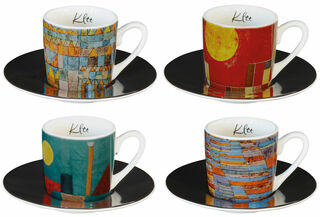Set of 4 espresso cups with artist motifs, porcelain
Set of 4 espresso cups with artist motifs, porcelain
Quick info
ars mundi Exclusive Edition | porcelain | capacity 0.085 l each | dishwasher safe | only available as a set
Detailed description
Set of 4 espresso cups with artist motifs, porcelain
High-quality porcelain set featuring Paul Klee's mosaic-like compositions. The black saucers create an effective contrast to the colourful pictures. This set consists of the motifs: "Castle and Sun", "Red Bridge", "Temple Quarter of Pert", and "Highway and Byways". Capacity 0.085 l each. Height of each cup 5.5 cm. Diameter of each saucer 12 cm. Dishwasher safe. ars mundi Exclusive Edition. Only available as a set.
Customer reviews
Sehr schöne Tassen
Toller Telefonservice, daraus resultierte die Sonderbehandlung meines Auftrages.
Somit war Eintreffen noch am 22.12. an der Empfängeradresse möglich und zeitgerechte Bescherung zu Weihnachten!
Vielen Dank und ... chapeau!
Sehr zufrieden, hat von der Bestellung bis zur Lieferung zu unserer vollsten Zufriedenheit geklappt.

About Paul Klee
He was called "the unique one" by his fellow artists: Paul Klee (1879-1940) shaped the understanding of modern art like hardly anyone else. With his mosaic-like composed works, he created a completely new style.
Born in Bern in 1879, Klee, a German-Swiss, turned out to be a double talent from an early age on: both his drawing skills and his violin skills promised him a musical as well as an artistic career. Klee decided on art and went to the Munich Art Academy, where he studied as a student of Franz von Stuck, among others. But it was not so much his academic studies that helped him develop an independent style but rather an extended study trip to Italy with his artist friends. Subtle symbolic depictions full of wit and humour became his trademark. Usually, just small formats and often merely drawings, enchant the viewer.
In 1906 Klee married the pianist Lily Stumpf and they had a son, Felix. The young family lived a very secluded life in Munich. It was only through the draughtsman Alfred Kubin that Klee became acquainted with the group known as the "Blaue Reiter". Klee quickly became friends with Kandinsky and Marc, with whom he shared the conviction that artistic creation was of spiritual nature.
A trip to the North African city of Tunis in 1914 with his painter friends August Macke and Louis Moilliet helped Klee to find new joy in colour and a genuine creative frenzy. "Color possesses me. I don't have to pursue it. It will possess me always, I know it. That is the meaning of this happy hour: Color and I are one. I am a painter." he writes in his diary. This was followed by countless watercolour paintings, with which he developed his own unique style.
Exhibitions organized by the Blaue Reiter made Klee famous. By the time he is appointed as a "master" by the Bauhaus, he already was a celebrated artist. In 1933, the National Socialist campaign against "degenerate art" forced Klee to leave Germany and settle back in Switzerland. With a true work mania, he tried to rebel against an incurable illness that conquers the painter, who is now internationally famous, only a few years later (1940).
Graphic or sculpture edition that was initiated by ars mundi and is available only at ars mundi or at distribution partners licensed by ars mundi.
Collective term for the painters and sculptors of the 20th century, such as Pablo Picasso, Salvador Dalí, Joan Miró, Marc Chagall and others, whose works are the most recognized in our times.
Ceramic product made of kaolin, quartz and feldspar.
Porcelain is formed by turning or pressing and figurative objects are cast. Complex objects have to be cast in separated steps and sections and then "assembled". After the moulding, the pieces are dried and "annealed" at about 900 °C. Next, the glaze will be applied and fired at temperatures between 1,240 °C and 1,445 °C. In renowned manufactures, the porcelain is painted by hand whereby each colour has to be fired individually and in compliance with narrow temperature tolerances.
Porcelain was invented in China and became widespread in Europe from the 16th century onwards. The first European porcelain factory was founded in Meissen, Germany in 1710.
Other famous European porcelain factories include Fürstenberg, Höchst, Schwarzburger Werkstätten, Lladró, Nymphenburg, KPM, Augarten, Sèvres, Limoges, Royal Copenhagen, Worcester. Individual factories label their products with their personal porcelain stamps so that for the collecter it is easy to identify their origin.


